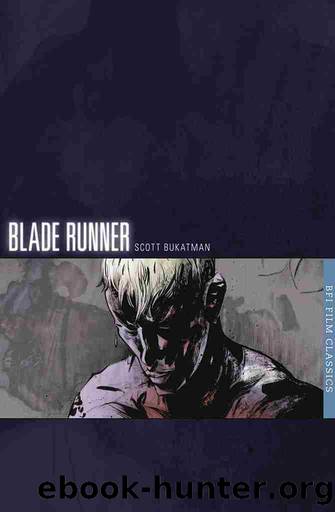Blade Runner by Scott Bukatman

Author:Scott Bukatman
Language: eng
Format: epub
Publisher: Bloomsbury Publishing
Published: 2019-04-15T00:00:00+00:00
Pris
The viewer is presented with two distinct spaces in this shot. The first is the superbly detailed urban space that dominates the film, visible outside the spinner. The panorama is augmented by the second space, constituted by the data screens of the cockpit, which reveals the existence of an âinvisibleâ traffic corridor. An order exists to the movements of the city, even if that order is not always evident to the unaided eye. The shot, with all of its composited elements and brilliant synchronisation of views, permits a totalising gaze of impossible clarity. The viewer is given a privileged tour of a futurity that is richly layered, bewildering but still familiar. The total effect is one of scopic pleasure: the viewer sees and deduces how (and that) the future works.
For me, the sequence recalls the trolley ride in Sunrise (1927), perhaps the most profound expression of panoramic perception in the history of the cinema.58 After nearly strangling his wife, the man begs for forgiveness, but in terror and grief she runs from lakeshore to woods, boarding an improbable city-bound trolley. He follows, and as they stand at the front of the moving car the world beyond the windows slides laterally past them (and us). They seem fixed and centred in space, while the world itself has become unmoored. The sequence speaks, with impossible eloquence, of separation and disconnection, even as this most literal of tracking shots links rural and urban spaces in a fluid continuum. Despite its evident solidity, the world takes on a hallucinatory mutability. Our attention is divided between their unspeaking trauma and the complexly shifting space beyond the windows; we are divided between alienation and exploration.
Some of the poignance comes from the inescapable sense of loss built into the very aesthetic of the shot. Whatever comes into view will just as surely be removed, to be replaced, and replaced again. Absence and distance structure the image. Leo Charney has located variations on this absence as fundamental to the fascination that cinema exerted on such philosophers and theorists as Henri Bergson, Walter Benjamin and Jean Epstein. Characteristically, âcinema transformed the hollow present into a new form of experience, as the vacated present opened space for the viewerâs activity. Experience arose in â was defined by and in â the space vacated by the presentâs movement away from itself.â59 In Sunrise, the movement of the world past the fixed frame of the camera becomes a metaphor for cinematic experience, in which plenitude and loss coexist in an unresolved dance of marked but unfulfilled desires.
Compare this to that expansive hovercraft flight in Blade Runner. Again the world slides past the window, but now we luxuriate without reservation in the revelation of urban immensity and complexity. Special effects sequences are often about revelation rather than absence â they evoke presence. A further momentâs reflection, though, demonstrates that Blade Runner, with its retrofitted future built on the debris of the past â a past which is our present â does insist on a sense of absence and separation not dissimilar to Sunrise.
Download
This site does not store any files on its server. We only index and link to content provided by other sites. Please contact the content providers to delete copyright contents if any and email us, we'll remove relevant links or contents immediately.
The Kite Runner by Khaled Hosseini(4525)
Gerald's Game by Stephen King(3960)
The Perils of Being Moderately Famous by Soha Ali Khan(3808)
Dialogue by Robert McKee(3636)
Story: Substance, Structure, Style and the Principles of Screenwriting by Robert McKee(3023)
The 101 Dalmatians by Dodie Smith(2966)
The Pixar Touch by David A. Price(2768)
Confessions of a Video Vixen by Karrine Steffans(2705)
How Music Works by David Byrne(2573)
Fantastic Beasts: The Crimes of Grindelwald by J. K. Rowling(2571)
Slugfest by Reed Tucker(2446)
Harry Potter 4 - Harry Potter and The Goblet of Fire by J.K.Rowling(2445)
The Mental Game of Writing: How to Overcome Obstacles, Stay Creative and Productive, and Free Your Mind for Success by James Scott Bell(2414)
Wildflower by Drew Barrymore(2135)
Scandals of Classic Hollywood: Sex, Deviance, and Drama from the Golden Age of American Cinema by Anne Helen Petersen(2133)
Casting Might-Have-Beens: A Film by Film Directory of Actors Considered for Roles Given to Others by Mell Eila(2091)
Screenplay: The Foundations of Screenwriting by Syd Field(2089)
Robin by Dave Itzkoff(2029)
The Complete H. P. Lovecraft Reader by H.P. Lovecraft(2007)
